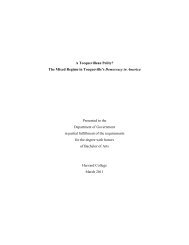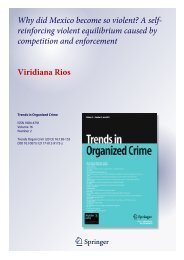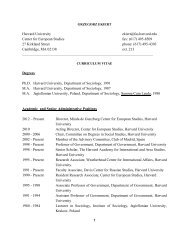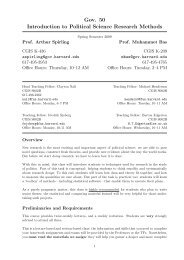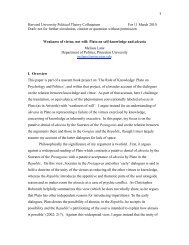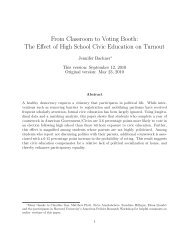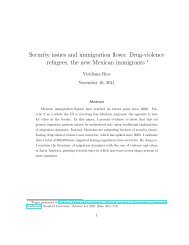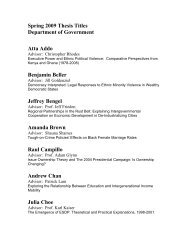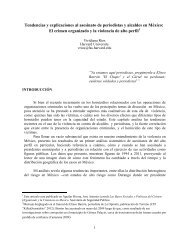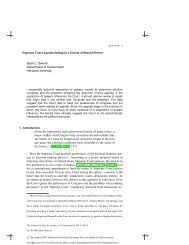Why are Mexican mayors getting killed by traffickers? The dynamics ...
Why are Mexican mayors getting killed by traffickers? The dynamics ...
Why are Mexican mayors getting killed by traffickers? The dynamics ...
You also want an ePaper? Increase the reach of your titles
YUMPU automatically turns print PDFs into web optimized ePapers that Google loves.
3.1 Demand side: Bribing, threatening or killing<br />
Definition 2: N decides between paying b, and exerting political violence (k) (i.e. killing A)<br />
<strong>The</strong> traditional Silver-and-Lead narrative understands killing as a substitute for bribing, and<br />
predicts violence would be more common as <strong>traffickers</strong> become relatively more powerful than the<br />
state. When <strong>traffickers</strong> <strong>are</strong> powerful enough as to posses a system capable of killing politicians,<br />
and state is weak enough as to be unable to enforce law against assassins, costly bribes will be<br />
substituted <strong>by</strong> killings. Political violence thus is a function of criminals’ power. As the relative<br />
power of the state versus DTOs diminishes, organized crime is supposed to become more violent<br />
(Godson 2003; Baylor and Pimentel (2001)) not only because (a) DTOs have the technology<br />
to kill politicians but because (b) a weak state cannot stop crime organizations from fighting<br />
among themselves. Under this logic, it is the state the one who can keep violence controlled;<br />
an “unleashed” crime is always bloody.<br />
In Mexico, the standard story argues, the arrival of opposition to power undermined the<br />
ability of the government to keep corruption agreements between the hegemonic ruling party<br />
(Institutional Revolutionary Party, PRI Partido Revolucionario Institucional) and criminal organizations.<br />
When the government of Vicente Fox, an opposition leader from the National<br />
Action Party (PAN Partido Accion Nacional) took office in 2000, it lacked of the expertise,<br />
power and/or networks to force criminals to conduct their business in peace. By then, the PRI<br />
had held power for more than seventy years, period at which it kept a pax mafiosa <strong>by</strong> extorting<br />
criminal organizations (Astorga 2006, Mercurio 2006). When <strong>Mexican</strong> DTOs saw themselves<br />
free from PRI supervision, violence exploited (Ravelo 2001, Gomez 1999).<br />
Preferences for violence though, I argue, <strong>are</strong> much more subtle than the traditional narrative<br />
argues. Violence is no free lunch. Three things have to be considered: (a) Killing is not always<br />
cheaper than bribing, even for powerful <strong>traffickers</strong>; (b) criminals do not always find it attractive<br />
to fight violently between each other; and (c) criminals cannot commit to kill with complete<br />
certain, they can only commit to try (very hard) to kill.<br />
Indeed, the balance of power between the state and <strong>traffickers</strong> matters for violence. Killing<br />
is more common when such action is expected to cause less negative consequences. As Alfredo<br />
Corchado, chief of the <strong>Mexican</strong> Buro from the Dallas Morning, and one of the most important<br />
reporters of drug trafficking activities in Mexico, told me when I asked him what measures he<br />
took to reduce his chances to be assassinated: “I make sure my batch from the Dallas is very<br />
visible, they would not d<strong>are</strong> to kill a gringo, it would be too dangerous.” Being a first generation<br />
<strong>Mexican</strong> American though, he joked: “the good news is that I am a gringo reporter, the bad<br />
one is that nobody could tell (Corchado 2009).” Alfredo is right. Traffickers have not d<strong>are</strong><br />
to kill a foreign reporter, but have <strong>killed</strong> 11 <strong>Mexican</strong> reporters, and disappe<strong>are</strong>d 7 more since<br />
2007. <strong>The</strong>y also target more local media than higher-profile national media. Only 4 out of the<br />
8



